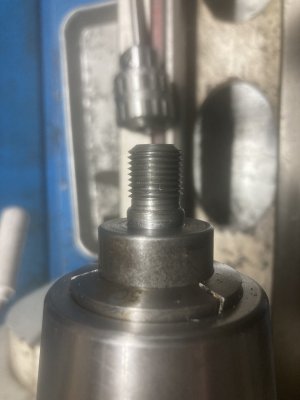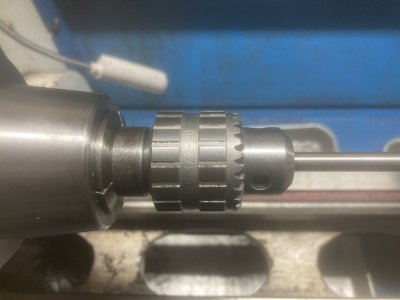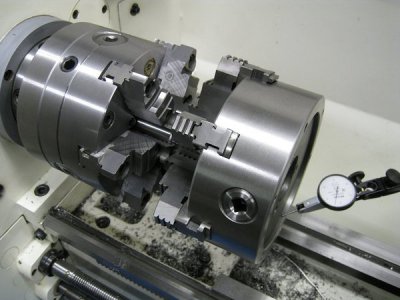Looking advice from the experts! I am machining an arbor for a bench motor. I bought a fairly high dollar LFA 0-3/8 Drill chuck. Mounting is 1/2"-20 with a flat head 10-32 screw in the center. I am on my third arbor. The first one I totally screwed it up. I made an adapter from 1" 4130. A 1/2" reamed hole about 1-5/8" long in the motor side. I made a stub shaft for the three jaw and then put the arbor on it and turned the side for the chuck. I was lazy. Instead of single pointing the thread, I used a die and the chuck was so crooked that it would rap you on the knuckles. My bad.
I then made an arbor out of 5/8" 1018. Turned it down and single pointed the thread. Not much better.
I then made an arbor out of 1" 1018 in a collet. I turned the shaft down to .505. Left a little ledge, say .100 long for the chuck to sit on. Parted a thread relief area, turned the shaft down to .498 and single pointed the thread. At this point, the shaft and face are perfect. A dial indicator vibrates a little, but not enough to read. The thread itself has a .001 runout. When you install the chuck, the runout on the chuck body, just ahead of the holes is around .003-5. Installing a gauge pin, endmill, drill rod the runout is .005-6. Forget about measuring out an inch or two. I had readings of .007-10.
The chuck tightly touches the face of the arbor. I used a cigarette paper in between and was able to reduce the runout to around .002 on the chuck body. I have a replacement chuck coming to see if this one is bad. Getting a little hassle because the vendor considers it used. I guess screwing it on an arbor in a lathe must devalue it. I need a 0 closing chuck to handle the small number drills. I am expecting .001-2 or maybe a little better runout with a pin at the chuck it self.
I have less runout then this on a 50 year old Delta drill press, so am I expecting too much? What is a realistic runout expectation, or what other way would you solve the problem. Thanks Chewy
I then made an arbor out of 5/8" 1018. Turned it down and single pointed the thread. Not much better.
I then made an arbor out of 1" 1018 in a collet. I turned the shaft down to .505. Left a little ledge, say .100 long for the chuck to sit on. Parted a thread relief area, turned the shaft down to .498 and single pointed the thread. At this point, the shaft and face are perfect. A dial indicator vibrates a little, but not enough to read. The thread itself has a .001 runout. When you install the chuck, the runout on the chuck body, just ahead of the holes is around .003-5. Installing a gauge pin, endmill, drill rod the runout is .005-6. Forget about measuring out an inch or two. I had readings of .007-10.
The chuck tightly touches the face of the arbor. I used a cigarette paper in between and was able to reduce the runout to around .002 on the chuck body. I have a replacement chuck coming to see if this one is bad. Getting a little hassle because the vendor considers it used. I guess screwing it on an arbor in a lathe must devalue it. I need a 0 closing chuck to handle the small number drills. I am expecting .001-2 or maybe a little better runout with a pin at the chuck it self.
I have less runout then this on a 50 year old Delta drill press, so am I expecting too much? What is a realistic runout expectation, or what other way would you solve the problem. Thanks Chewy


 Or , do you need one to make the other ?
Or , do you need one to make the other ?

